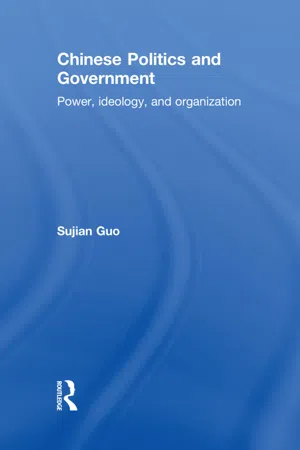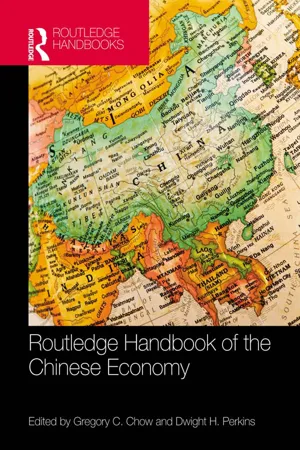Command Economy
A command economy is a system in which the government makes all decisions about production, distribution, and pricing of goods and services. This centralized approach contrasts with a market economy, where these decisions are made by individuals and businesses. In a command economy, the government typically owns the means of production and sets production targets and resource allocation.
5 Key excerpts on "Command Economy"
- eBook - ePub
Chinese Politics and Government
Power, Ideology and Organization
- Sujian Guo(Author)
- 2012(Publication Date)
- Routledge(Publisher)
...In distinguishing a centrally planned Command Economy from a free market economy, five fundamental questions can be formulated. The answers to these questions establish the nature and characteristics of the two economic systems 1 (see Table 15.1 for explanations). Table 15.1 Two ideal-type political economies 2 Key points Market economy Command Economy 1. Control of factors of production Every economic actor controls own factors State owns and controls all factors of production 2. Production decisions Sum of all private actors’ decisions (“invisible hand” of market); demand oriented State decisions defined in detailed plan; supply oriented 3. Value established Exchange value in the market State sets values attached to all goods 4. Distribution decisions Choices by private actors State determines who will receive what products at what levels 5. Role of the state Generally passive; enforces rules, provides minimal protection to actors State dominates, owns, plans, controls, and regulates all economic activities Note: The means of production include energy resources, land, raw materials, tools, machines, and factories. The means of exchange include transportation and communications facilities, wholesale and retail outlets, banking and credit institutions, etc. 3 Who controls the means of production and the factors of production? Who determines what goods are produced? Who establishes the value attached to different resources and goods? Who decides how resources and goods will be distributed? What is the role of the state? In the history of economics, Adam Smith and Karl Marx presented two ideal types: the “free market economy” of capitalism and the “planned Command Economy” of communism. In a free market economy, it is private citizens or private firms who own the private property or the means of production, and therefore control their own factors of production, determine what should be produced, and have the right to the residual income from their asset...
- eBook - ePub
- Danny Myers(Author)
- 2018(Publication Date)
- Routledge(Publisher)
...Producers will be guided (by the discipline of the marketplace) to combine resources in the cheapest possible way to achieve a particular standard or quality. Those firms that combine resources in the most efficient manner will earn the highest profits and force losses on their competitors. Competitors will be driven out of business or forced to combine resources in the same way as the profit-makers. For whom The for whom question is concerned with the distribution of goods after production. How is the pie divided? In a free market economy, production and distribution are closely linked, because incomes are generated as goods are produced. People get paid according to their productivity; that is, a person’s income reflects the value that the market system places on that person’s resources. Since income largely determines one’s share of the output pie, what people get out of the free market economy is based on what they put into it. The centrally planned model A centrally planned system (also referred to as a Command Economy) is typically characterised by a dominant government sector, coupled with the common ownership of resources. In other words, there is a central planning authority that takes the place of the price mechanism in allocating resources. The precise nature of a central planning authority depends upon the political system governing the economy. Indeed, it is worth noting that the terms ‘socialist’ and ‘communist’ properly refer to political systems and not economic systems. In fact, a right-wing dictatorship could operate a centrally planned economic system as effectively as a left-wing commune. The common motivation for having a centrally planned system is the conviction that government commands are more likely to produce the ‘right’ mix of output because state planners have the opportunity to direct resources to society’s most pressing needs. As the respected US economist J.K...
- eBook - ePub
- Harlan M. Smith(Author)
- 2016(Publication Date)
- Routledge(Publisher)
...Sustainability is affected by pollution, overloading the life-support system, and depletion of natural resource capital. A common textbook treatment classifies economic systems as traditional, command, and market systems. In the first type of system, the above basic things are determined by tradition; there are customary ways of doing everything. Simple preindustrial economies are characterized thus. By contrast, command economies are illustrated by centrally planned communist economies where the basic determinations are made by government officials and carried out by government command. The third alternative is for the basic determinations to be made by markets, that is, through buying and selling activities. Indeed one may get the idea that all economic activity is being carried on according to custom in the traditional economic system, and by command in the command type of economy, and by buying and selling in market type economies. Such a picture is misleading, for although there are large and contrasting differences among the three types of economies characterized by the dominant roles of three factors—custom, command, and market —all three factors play a significant role in every economy. The task of the student of economics is to identify the roles of each even where they are sometimes unnoticed, at least by textbook treatments. These comments will be confined to a few illustrations in command and market economies. Consider first the role of custom in a market economy. We sometimes speak of setting the price for a product as involving the customary markup over cost. When collective bargaining in some industries results in a certain percentage wage increase, this has quite an influence on the outcome in many other industries, in order to maintain the customary pattern of relative wages. Much of the economy is not a matter of market prices, but of household production, and recreational and organizational activities...
- eBook - ePub
- Dwight H. Perkins(Author)
- 2013(Publication Date)
- Harvard University Press(Publisher)
...Both were command economies patterned on the Soviet system. Market forces played only a minor role, mainly in the retail sales of secondary consumer goods. All industrial inputs and most outputs were allocated by administrative means through government channels or through informal arrangements between individual state-owned enterprises. Major consumer goods such as grain were allocated using ration coupons. Who got what was decided by thousands of central planners in the State Planning Commission. The financial system, with a monobank that included both central bank and commercial bank functions, was structured for the primary purpose of monitoring and enforcing the central plan. The plan targets had the force of law, but since there were so many targets it was impossible to construct a consistent set, so enterprise managers had to use their own judgment as to which targets mattered more than others. This system makes most sense in a wartime economy, and the original model the Soviet Union learned from was Germany in World War I. In wartime, military procurement planners do not decide how many tanks or fighter planes they need and then raise the price of those items and hope that private entrepreneurs respond. They order the enterprises, whether private or public, to restructure so that they can provide whatever the military requires. These orders are backed up by law, patriotism, and social pressure on the unpatriotic. In a very real sense, China, the Soviet Union, and Vietnam were all wartime economies when this system was first adopted. The Soviet Union in the 1930s and 1940s faced the threat and then the reality of German invasion. China fought the United States in Korea from 1950 through 1953 and then faced an embargo on trade with most market economies after 1953 until it was removed in the late 1960s...
- eBook - ePub
- Gregory C. Chow, Dwight H. Perkins(Authors)
- 2014(Publication Date)
- Routledge(Publisher)
...3 THE CENTRALLY PLANNED Command Economy (1949–84) Dwight H. Perkins Introduction When the Chinese Communist Party took over the government of China in 1949, it set out to fundamentally change the way the economy was organized. Initially the main task was to control the hyperinflation of the pre-1949 years and this was followed by the state takeover of ownership of most of industry and commerce. This in turn was followed by the replacement of household agriculture with agricultural producer cooperatives, a process largely accomplished in the winter of 1955–6. With the state takeover of industry and commerce, the government then moved to replace the production and distribution system, which up to that point had largely been governed by market forces, with a system of central planning where the government decided what would be produced, who would produce it, and from whom enterprises would receive the inputs required for this production. This system of government control of the production and allocation of industrial products was patterned on the system then in place in the Soviet Union. The decisions as to what to produce with what inputs was made by a central planning agency that in China was called the State Planning Commission (SPC). The SPC drew up output targets for each industry together with targets indicating which inputs in what quantity would be used to produce those products. These output and input targets were then broken down into comparable targets for individual enterprises. The managers of these enterprises were then expected to carry out their part of the plan as spelled out by these SPC targets. There were a variety of implementation measures designed to ensure that the managers would do precisely that and these will be described below...




